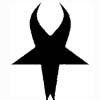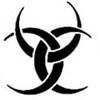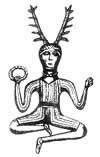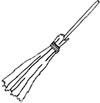
Over 16,529,819 people are on fubar.
What are you waiting for?

 Hidden pentacles are pentacles disguised in more intricate designs, and may be worn when it is not safe or appropriate to wear a 'standard' pentacle. Many such stylized designs are worn which can be recognized by other believers, but less apparent to outsiders. Sometimes called a 'flower pentacle,' they have a less "occult" look and are less likely to cause problems with non-pagan family or in the workplace.
Hidden pentacles are pentacles disguised in more intricate designs, and may be worn when it is not safe or appropriate to wear a 'standard' pentacle. Many such stylized designs are worn which can be recognized by other believers, but less apparent to outsiders. Sometimes called a 'flower pentacle,' they have a less "occult" look and are less likely to cause problems with non-pagan family or in the workplace.

 For a thorough explanation of the history and meaning of this symbol throughout history: Pentagram.
For a thorough explanation of the history and meaning of this symbol throughout history: Pentagram.
 This is a stylized representation of the Horned God, who in Wicca represents the masculine polarity of the universe. The horned god is the archetypal horned Shaman, related to the ancient Gods of vegetation and the hunt: Greek Pan, the Celtic Cernunnos, and the Egyptian Ammon. This symbol is sometimes referred to as the "horn moon," and as such, is also a symbol of the Goddess Diana, especially in Dianic Wicca.
Another Horned God image, created from a pentacle, this one with a distinctive Pan goat appearance:
This is a stylized representation of the Horned God, who in Wicca represents the masculine polarity of the universe. The horned god is the archetypal horned Shaman, related to the ancient Gods of vegetation and the hunt: Greek Pan, the Celtic Cernunnos, and the Egyptian Ammon. This symbol is sometimes referred to as the "horn moon," and as such, is also a symbol of the Goddess Diana, especially in Dianic Wicca.
Another Horned God image, created from a pentacle, this one with a distinctive Pan goat appearance:
 A similar symbol, drawn from Egyptian hieroglyphs, representing the Cow Goddess Hathor, is sometimes used by Egyptian Recon or feminine centered Pagans:
A similar symbol, drawn from Egyptian hieroglyphs, representing the Cow Goddess Hathor, is sometimes used by Egyptian Recon or feminine centered Pagans:
 There are several styles of the Lunar Triple Goddess symbol, representing the three aspects of the moon (waxing, waning, and full) and womankind (mother, maiden, crone), as well as the Lady, or Goddess, the feminine polarity of the universe:
There are several styles of the Lunar Triple Goddess symbol, representing the three aspects of the moon (waxing, waning, and full) and womankind (mother, maiden, crone), as well as the Lady, or Goddess, the feminine polarity of the universe:

 The image below is of Cernunnos, an ancient Celtic horned deity who is often considered the origin of the concept of the Wiccan Horned God, symbolizes the masculine power of nature, especially the domain of forests and the animals that dwell in them:
The image below is of Cernunnos, an ancient Celtic horned deity who is often considered the origin of the concept of the Wiccan Horned God, symbolizes the masculine power of nature, especially the domain of forests and the animals that dwell in them:
 The familiar symbol below is a simplified silhouette of a paleolithic Egyptian mother Goddess, probably a prototype of the Goddess Isis, and is often used to symbolize the "Lady," the feminine deity of Wicca:
The familiar symbol below is a simplified silhouette of a paleolithic Egyptian mother Goddess, probably a prototype of the Goddess Isis, and is often used to symbolize the "Lady," the feminine deity of Wicca:
 The eight-pointed Wheel of the Year symbol marks the important holy days, or Sabbats, in the Wiccan Ritual calendar. It is derived from the sun wheel, or solar cross, a pre-Christian European calendar marking the Solstices and Equinoxes:
The eight-pointed Wheel of the Year symbol marks the important holy days, or Sabbats, in the Wiccan Ritual calendar. It is derived from the sun wheel, or solar cross, a pre-Christian European calendar marking the Solstices and Equinoxes:
 The so-called Witch's Sign is used in some traditions to mark ritual tools. It is similar to the solar cross, but its exact origin is unknown (It is similar to the Roman numeral thirteen, and reader suggests this may represent the coven of thirteen members) (Similar devices were used in the medieval period to mark time):
The so-called Witch's Sign is used in some traditions to mark ritual tools. It is similar to the solar cross, but its exact origin is unknown (It is similar to the Roman numeral thirteen, and reader suggests this may represent the coven of thirteen members) (Similar devices were used in the medieval period to mark time):
 Hecate's wheel is an ancient Greek symbol, and is an emblem of the Moon Goddess Hecate (Diana Lucifera), and her triple aspect. It is generally used by practitioners of Hellenic Recon or Dianic Traditions:
Hecate's wheel is an ancient Greek symbol, and is an emblem of the Moon Goddess Hecate (Diana Lucifera), and her triple aspect. It is generally used by practitioners of Hellenic Recon or Dianic Traditions:
 Hecate's Wheel
The Emblem of Seax-Wicca, an Anglo-Saxon influenced branch of Wicca, symbolizes the sun, moon, and the eight Sabbats, or holy days:
Hecate's Wheel
The Emblem of Seax-Wicca, an Anglo-Saxon influenced branch of Wicca, symbolizes the sun, moon, and the eight Sabbats, or holy days:
 The Elven Star (or Fairy star), a seven pointed star, is associated with practitioners of Fairy (also Feri, Faerie, etc.), a Celtic-tinged Wicca:
The Elven Star (or Fairy star), a seven pointed star, is associated with practitioners of Fairy (also Feri, Faerie, etc.), a Celtic-tinged Wicca:
 The Elven Star is used interchangeably with or in place of the pentagram in Faery traditions in Wicca. Most often, the points are ascribed various correspondences, including seven directions (the four cardinal directions, plus above, below, and within) , seven magical elements (the four alchemical elements plus three additional, which vary- sometimes, magic, light, life), or seven magical places- sun, moon, sea, sky, wood, wind, and spirit/interconnection)
For more uses of the seven pointed star, see: septagram.
Traditional Wiccan ritual tools:
The four most commonly used ritual tools in Wicca are derived from the magickal tools used by Ritual magicians of the Renaissance. They symbolize the four ancient elements, and are used ritually to channel their powers. They are directly related to the suit signs on tarot cards and the four worlds of the kabbalah.
The cup or chalice is a symbol of the element of water, a feminine element representing intuition, gestation, psychic ability, and the subconscious. The Cup also stands in as a symbol of the Goddess, of the womb, and the female generative organs. The chalice is sometimes interchangeable with the cauldron.
The Elven Star is used interchangeably with or in place of the pentagram in Faery traditions in Wicca. Most often, the points are ascribed various correspondences, including seven directions (the four cardinal directions, plus above, below, and within) , seven magical elements (the four alchemical elements plus three additional, which vary- sometimes, magic, light, life), or seven magical places- sun, moon, sea, sky, wood, wind, and spirit/interconnection)
For more uses of the seven pointed star, see: septagram.
Traditional Wiccan ritual tools:
The four most commonly used ritual tools in Wicca are derived from the magickal tools used by Ritual magicians of the Renaissance. They symbolize the four ancient elements, and are used ritually to channel their powers. They are directly related to the suit signs on tarot cards and the four worlds of the kabbalah.
The cup or chalice is a symbol of the element of water, a feminine element representing intuition, gestation, psychic ability, and the subconscious. The Cup also stands in as a symbol of the Goddess, of the womb, and the female generative organs. The chalice is sometimes interchangeable with the cauldron.
 The athame or ritual dagger (sometimes, a sword), is a symbol of fire. The Athame represents the fire element, and the masculine qualities of consciousness, action, force, and strength. The athame is used to direct energy and is employed in the casting of circles. An athame is traditionally black handled and dull, but as the knife is considered a personal emblem, there is a lot of variety in actual practice- one might see anything from a hunting knife to a deer antler used as an athame. The use of the athame draws from earlier ritual magic, and predates Wicca.
The athame or ritual dagger (sometimes, a sword), is a symbol of fire. The Athame represents the fire element, and the masculine qualities of consciousness, action, force, and strength. The athame is used to direct energy and is employed in the casting of circles. An athame is traditionally black handled and dull, but as the knife is considered a personal emblem, there is a lot of variety in actual practice- one might see anything from a hunting knife to a deer antler used as an athame. The use of the athame draws from earlier ritual magic, and predates Wicca.
 The chalice and the blade brought together symbolize sexual union.
The dish, or paten, also known as a pentacle in most Wiccan and Ritual Magick tradition. This item originated with the Catholic Church, and was one of the four Grail Hallows and came to Wicca via Ritual Magick, where it was a symbol of the element of earth:
The chalice and the blade brought together symbolize sexual union.
The dish, or paten, also known as a pentacle in most Wiccan and Ritual Magick tradition. This item originated with the Catholic Church, and was one of the four Grail Hallows and came to Wicca via Ritual Magick, where it was a symbol of the element of earth:
 The wand is a symbol of air. It should be noted that in Ritual Magick, wands are of the fire element, and the dagger is of air. Wiccan practice generally reverses these designations, largely due to the union of the chalice with the dagger in ritual.
Wiccan wands are usually made of wood (typically hawthorn or ash), copper, or crystal, and can be quite ornate and personal in their design. Of all the witch's tools, it is the most personal:
The wand is a symbol of air. It should be noted that in Ritual Magick, wands are of the fire element, and the dagger is of air. Wiccan practice generally reverses these designations, largely due to the union of the chalice with the dagger in ritual.
Wiccan wands are usually made of wood (typically hawthorn or ash), copper, or crystal, and can be quite ornate and personal in their design. Of all the witch's tools, it is the most personal:
 Additional Tools:
The Besom, or Broom, fills a largely symbolic role in Wiccan practice. Derived from European witchcraft folklore of broom dancing and flying, the broom is used today for symbolic cleansing or purification. A typical besom ritual uses the broom to "sweep" negative energy from a home or other space. The besom/broom is also a focal point in Wiccan handfasting marriages, where it acts as a stand-in threshold, which newlyweds jump to cement their vows.
Additional Tools:
The Besom, or Broom, fills a largely symbolic role in Wiccan practice. Derived from European witchcraft folklore of broom dancing and flying, the broom is used today for symbolic cleansing or purification. A typical besom ritual uses the broom to "sweep" negative energy from a home or other space. The besom/broom is also a focal point in Wiccan handfasting marriages, where it acts as a stand-in threshold, which newlyweds jump to cement their vows.
 Besom
The Scourge is usually seen only in older Wiccan traditions. The scourge is an implement, usually a small leather whip or cat'o'nine tails, used to gently strike a member for purposes of purification of purging in rituals. The scourge is also symbolic of spiritual discipline. It is derived from the symbolic ritual tools of the Egyptian god Osiris.
The Boline or Bolline is a small, sickle shaped knife used to gather herbs used in rituals and spells. The sickle shaped knife can be traced to Druid mistletoe customs, and is a lunar tool. (In Scottish paths, sometimes a kerfan, after the traditional dagger)
Besom
The Scourge is usually seen only in older Wiccan traditions. The scourge is an implement, usually a small leather whip or cat'o'nine tails, used to gently strike a member for purposes of purification of purging in rituals. The scourge is also symbolic of spiritual discipline. It is derived from the symbolic ritual tools of the Egyptian god Osiris.
The Boline or Bolline is a small, sickle shaped knife used to gather herbs used in rituals and spells. The sickle shaped knife can be traced to Druid mistletoe customs, and is a lunar tool. (In Scottish paths, sometimes a kerfan, after the traditional dagger)
 The White-handled knife is used by Gardnerian and other traditional Wiccan groups for ritual cutting of cords and other used where a dull athame would not be used, and in the construction of other magical tools.
The Cauldron is drawn from ancient Celtic mythology, and is sometimes called the Cup or Cauldron of Cerridwen. The ancient Celts used cauldrons for food and in ritual as an emblem of abundance and divine inspiration. In Celtic mythology and folklore, the cauldron provides infinite sustenance or artistic inspiration.
As a Wiccan ritual tool, the cauldron is mostly symbolic. Most often used to represent the fire or water elements, the cauldron is sometimes employed for scrying, for mixing herbs, for consecration, or to hold the ingredients for a spell. It is generally held to be a feminine symbol:
The White-handled knife is used by Gardnerian and other traditional Wiccan groups for ritual cutting of cords and other used where a dull athame would not be used, and in the construction of other magical tools.
The Cauldron is drawn from ancient Celtic mythology, and is sometimes called the Cup or Cauldron of Cerridwen. The ancient Celts used cauldrons for food and in ritual as an emblem of abundance and divine inspiration. In Celtic mythology and folklore, the cauldron provides infinite sustenance or artistic inspiration.
As a Wiccan ritual tool, the cauldron is mostly symbolic. Most often used to represent the fire or water elements, the cauldron is sometimes employed for scrying, for mixing herbs, for consecration, or to hold the ingredients for a spell. It is generally held to be a feminine symbol:
 The Theban alphabet, also known as "witch's runes," is a medieval magical alphabet ascribed to Honorious, a semi-mythical magus. The Theban alphabet is used by Gardnerian and other traditional Wiccans as a substitution cipher to ensure the privacy of magical writings.
The Theban alphabet, also known as "witch's runes," is a medieval magical alphabet ascribed to Honorious, a semi-mythical magus. The Theban alphabet is used by Gardnerian and other traditional Wiccans as a substitution cipher to ensure the privacy of magical writings.
 Related symbols to come....
Related symbols to come....